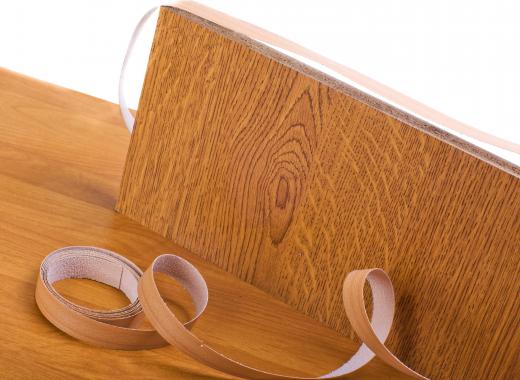A composite panel is a type of building material used in place of traditional wood or steel. These panels are much more lightweight than solid wood or steel, but offer similar levels of strength and structural support. There are three basic types of composite panels, including engineered wood, aluminum, and fiberglass units. Each of these panels may consist of multiple layers of the same material or a lightweight core sandwiched between sheets of some type of protective material.
An engineered wood composite panel is typically made of pressed wood fibers or sawdust blended with epoxy resin. The wood is shredded or ground into a fine pulp, then dried. The dried fibers are mixed with the epoxy and formed into sheets under high levels of heat and pressure. Depending on the type of wood fibers that are used, these panels may be known as medium-density fiberboard (MDF), particleboard, or hardboard.

Composite wood panels are used in many different construction applications, and have greatly reduced the demand for plywood. Engineered wood panels are used to add structural stability to wall framing, or to construct floors and roofs. Because these panels generally have a smooth, uniform appearance, they can also be used to make doors and furnishings. Many cabinets and other types of furniture are made using a composite panel topped with a thin layer of wood veneer. This can be used to mimic the appearance of solid wood at just a fraction of the cost.
Aluminum composite products are often known as "sandwich panels." They consist of a lightweight core wrapped in thin sheets of aluminum. The core can be made using rigid foam or resin-coated cardboard formed into a honeycomb shape. These panels offer similar levels of strength to traditional steel construction, but the weight is greatly reduced. These panels are used in the transportation and aerospace industries to create lightweight vehicles and places that are still strong enough to carry a full load.
A composite panel may also be made from a combination of fiberglass, foam, and epoxy resin. Typically these materials are sandwiched together so that sheets of fiberglass surround a foam core. This type of composite panel is commonly used in water-based applications. Many surfboards and kayaks are made from fiberglass panels, as are boats and other marine vessels. The light weight of the panels helps ensure the vessel will stay afloat, while the panel's high level of strength allows the vessel to carry passengers or freight.
